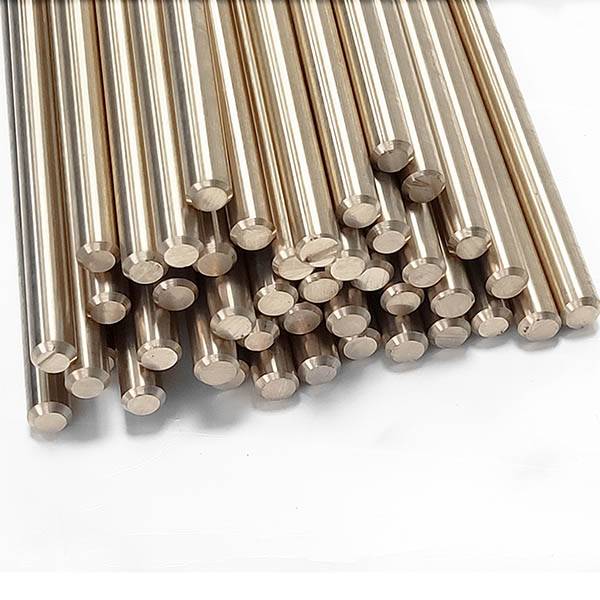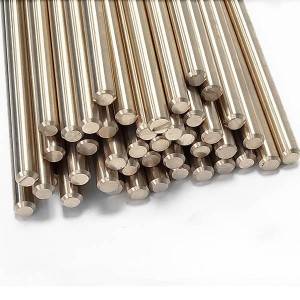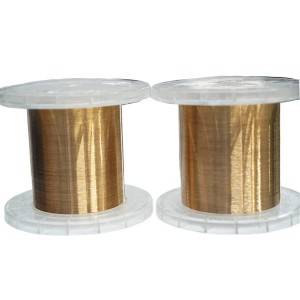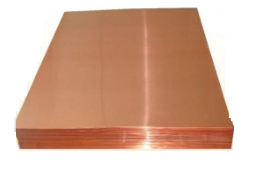Kinkou-96 Copper Alloy (Cu-9NI-6SN C72700)
1. Konpozisyon Chimik nan C72700
| Modèl | Ni | Sn | Mn | Pb | Zn | Fe | P | Enpurte | Cu |
| C72700 | 8.5-9.5 | 5.5-6.5 | 0.05-0.3 | ≤0.03 | ≤0.15 | ≤0.05 | ≤0.05 | ≤0.5 | Rès |
2. Pwopriyete fizik C72700
| Densite | 8.9 | (g/cm3) |
| Pwen k ap fonn | 968-1078 | (℃) |
| Koyefisyan ekspansyon tèmik | 17.25 | (X10-6/℃) 20-200 ℃ |
| Modil elastik | 120 | (GPA) |
| Rezistivite elektrik nan 20 ℃ |
| μω*cm |
| Pase | ≤19.5 |
|
| Presipitasyon redi | ≤15 |
|
| Konduktivite elektrik (IACS,%) |
| (% IACS) |
| ≥9 |
| |
| Presipitasyon redi (3 èdtan) | ≥12 |
|
| Modil torsyonèl | 50 | (GPA) |
| Tèmik konduktiviti nan 20 ℃ | 53.6 | (W/mk) |
| Koube fòs fatig | 450 | (MPA) |
3. Pwopriyete mekanik/eta C72700
1) pwodwi woule
| Deklare | Rez nan | Fòs rupture | Sede fòs | Elongaion | Koube* | Dite, Elastisite ak koube pwopriyete fatig (MPa) | ||
| HV | RM (MPA) | RP 0.2 (MPa) | A50mm (%) | Longitudinal // | Transverse⊥ | Longitudinal // | Transverse⊥ | |
| Pasè | ||||||||
| TB | 90-125 | 420-500 | ≥200 | ≥30 | 0.2 | 0.2 | 302 | 220 |
| Pasenching/frèt woule | ||||||||
| Td1 | 140-180 | 460-560 | ≥300 | ≥15 | 0.2 | 0.2 | 216 | 359 |
| Td2 | 160-200 | 540-640 | ≥400 | ≥10 | 0.2 | 0.2 | 275 | 390 |
| Td3 | 200-240 | 620-720 | ≥550 | ≥3 | 0.5 | 0.5 | 444 | 523 |
| TD4 | 220-260 | 700-820 | ≥600 | ≈1 | 2 | 1 | 467 | 568 |
| Tdx | ≤ 320 | ≥780 | ≥650 | ≈1 | 10 | 2 | 472 | 613 |
| Tretman chalè quenching/presipitasyon | ||||||||
| TF | 230-270 | 740-860 | ≥510 | ≥10 | 0.5 | 0.5 | 566 | 634 |
| Quenching/frèt woule/presipitasyon tretman chalè | ||||||||
| Th1 | 270-310 | 850-950 | ≥650 | ≥8 | 0.5 | 0.5 | 684 | 724 |
| Th2 | 290-320 | 880-980 | ≥720 | ≥8 | 1 | 1 | 730 | 770 |
| Th3 | 310-340 | 950-1050 | ≥800 | ≥4 | 1 | 1 | 829 | ≥840 |
| Th4 | 320-360 | 1000-1100 | ≥900 | ≈3 | 2 | 2 | ≥830 | ≥840 |
| Thx | ≤ 390 | ≥1050 | ≥950 | ≈1 | / | / | ≥830 | ≥840 |
| *: Dapre DIN 5011 (25/10/85), koube 90 ° ansanm direksyon an woule, divize reyon an minimòm koube pa epesè a detèmine rapò a R/T | ||||||||
2) Pwodwi trase
| Deklare | Rez nan | Fòs rupture | Sede fòs | Elongaion | Koyefisyan ekspansyon |
| HV | RM (MPA) | RP 0.2 (MPa) | A50mm (%) | Z% | |
| Pasè | |||||
| TB | ≤150 | 400-500 | ≥200 | ≥30 | ≥80 |
| Pasenching/frèt woule | |||||
| Td1 | 150-180 | 500-580 | ≥300 | ≥10 | ≥75 |
| Td2 | 180-230 | 550-720 | ≥500 | ≥3 | ≥70 |
| Td3 | 220-260 | 700-800 | ≥600 | ≥2 | ≥65 |
| TD4 | 230-300 | 780-880 | ≥700 | ≥1.5 | ≥60 |
| Tdx | 250-320 | 880-1000 | ≥800 | ≥0.1 | ≥50 |
|
|
|
|
|
|
|
| Deklare | HV | RM (MPA) | RP 0.2 (MPa) | A50mm (%) | Z% |
| Tretman chalè quenching/presipitasyon | |||||
| TF | ≤ 260 | 770-870 | ≥500 | ≥ 20 | ≥40 |
| Quenching/frèt woule/presipitasyon tretman chalè | |||||
| Th1 | 260-300 | 870-970 | ≥700 | ≥13 | ≥30 |
| Th2 | 290-310 | 930-1030 | ≥800 | ≥8 | ≥30 |
| Th3 | 310-330 | 1000-1100 | ≥900 | ≥5 | ≥30 |
| Th4 | 330-360 | 1100-1200 | ≥1000 | ≥2 | ≥30 |
| Thx | ≥350 | 1175-1300 | ≥1100 | ≥0.5 | ≥30 |
4. Tolerans estanda nan baton ak fil nan C72700
| Lèt | Dyamèt | Tolerans nan dyamèt | Tolerans nan dwat | |||
| pous | mm | pous | mm | pous | mm | |
| Fil elektrik | 0.2-0.39 | 6.35-9.9 | +/- 0.002 | +/- 0.05 | longè = 10ft, devyasyon < 0.25 pous | longè = 3048mm, devyasyon < 6.35mm |
| 0.4-0.74 | 10-18.9 | +0.005/-0 | +0.13/-0 | |||
| Baton | 0.75-1.6 | 19-40.9 | +0.02/+0.08 | +0.5/+2.0 | longè = 10ft, devyasyon < 0.5 pous | longè = 3048mm, devyasyon < 12mm |
| 1.61-2.75 | 41-70 | +0.02/+0.10 | +0.02/+0.10 | |||
| 2.76-3.25 | 70.1-82 | +0.02/+0.145 | +0.02/+0.145 | |||
| 3.26-6.00 | 83-152.4 | +0.02/+0.187 | +0.02/+0.187 | |||
| < 0.4 | < 10 | +/- 0.002 | +/- 0.05 |
|
| |
5. Aplikasyon nan C72700
Ranplase alyaj kwiv Beryllium
Yo itilize li pou linèt, elektrisyen, elèktromekanik, elektwonik, konektè, otomobil, aparèy nan kay la, endistri spectad, vire pati







